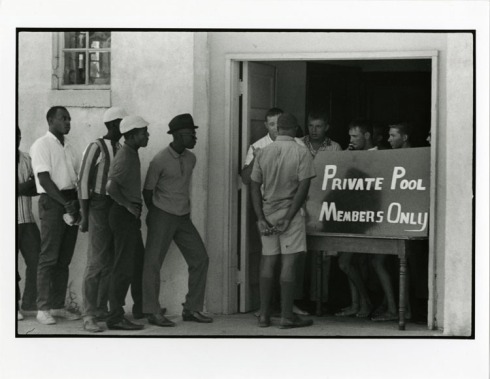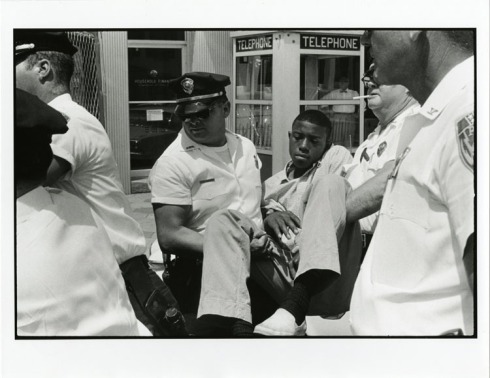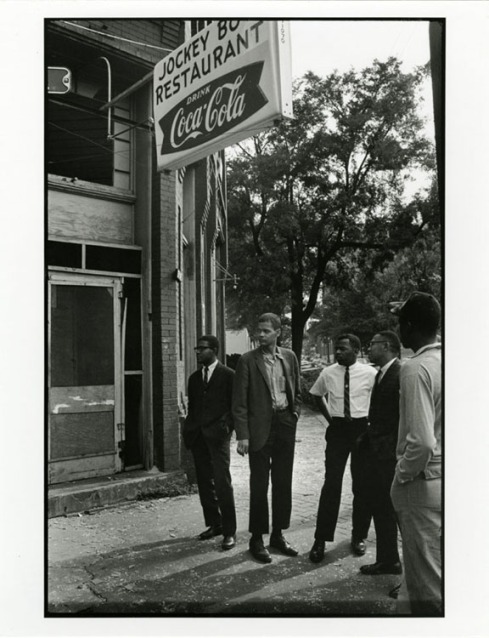You are currently browsing the tag archive for the ‘Danny Lyon’ tag.

Sean O’Hagan writes:
Lyon was a pioneer of what might be called immersive photojournalism, steeping himself in his subject matter in the manner of pioneering 60s writers of the New Journalism school such as Tom Wolfe and Hunter S Thompson. He builds the visual narrative around extended personal accounts by selected inmates, the often intimate descriptions of life inside illuminating his already powerful images. “The text of the book, compiled from prison records and convict writings, presents the lives of a few of these men,” he writes in his introduction. “They are the heroes of this book. I knew each of them as well as a free man can.”
[…] On every level, then, Danny Lyon’s approach flies in the face of detached documentary reporting, but it is this that also makes his work so viscerally forceful.
Read the full piece: Conversations With the Dead: Book review – 60s prison life in the US
Memories of the Southern Civil Rights Movement
2014 is the 50th anniversary of the passage of The Civil Rights Act, the landmark legislation that prohibits discrimination on the basis of race, color, religion, sex or national origin.
Danny Lyon was the first staff photographer — between 1962 and 1964 — for the Student Non-Violent Coordinating Committee (SNCC). Lyon would go on to make some of the most important bodies of work about the American condition (The Bikeriders; Conversations With The Dead) and as such his very early work as a very young man is often overlooked.
The Etherton Gallery’s exhibition ‘Danny Lyon: Memories of the Southern Civil Rights Movement’ opened on Saturday and shows 50 silver gelatin prints from Selma, Birmingham, and Montgomery, Alabama; Albany, Georgia; and Danville, Virginia. We see images of student protests and mobilization against racism, lunch counter sit-ins, student beatings, tear gassings, the jailing of Martin Luther King Jr., and the unscheduled visit of a young Bob Dylan to SNCC headquarters in Greenwood, Mississippi. Lyon, was harassed, beaten and jailed during his two years as a staff photographer.
SOME THOUGHTS ON AZ
Where better to look back on an era in which society treated people with different coloured skin than in modern day Arizona? The passing of SB1070 in 2010 was a legislative bill that essentially permitted veiled racism and racial profiling. In activism, folks are always on the look out for new allies and for audiences who really need to hear the message. A message of anti-racism message and some historical perspective is vital for residents of Arizona currently. I’m not saying that people of Arizona are inherently racist; I am saying the services and institutions that claim to serve them have procedures that result in racist acts.
There are some fine activists in Arizona (they’ve necessarily and wonderfully organised) and this is particularly true of Tucson and some clever geographer-activist-academics. May Lyon’s photographs play their part in making Arizonans and us angry. Lyon would want nothing more than his show to leave us rageful at our society of inequality.
DETAILS
Etherton Gallery, 135 S. 6th Ave, Tucson, AZ 85701 Tel: 520.624.7370. Email: info@ethertongallery.com.
‘Danny Lyon: Memories of the Southern Civil Rights Movement’ runs through March 15, 2014.
All photos: Danny Lyon © Dektol.wordpress.com. Courtesy of the Etherton Gallery
IT just went up a notch.
The opinionated and fiercely political legendary photojournalist/writer Danny Lyon has just boosted the fundraising efforts of Prison Photography on the Road (PPOTR) by offering a modern print that would usually go for about three or four thousand dollars. You can buy it.
Danny emailed:
“This is a 1995 modern print made by Kelton. The negative was made by me in 1968. Ramsey Prison Cell Block, Texas Prison, 1968 was published on p.121 of [the book] Conversations with the Dead with the caption ‘Six Wing Cell Block’. List the selling price as $1,750.00. The whole point is to get money for your project.”
Quite the endorsement of PPOTR and a gesture of great generosity.
ANTICIPATION
I’ll be meeting Danny in November during PPOTR. Judging by the frankness and wit of this interview, it’ll be a fierce and fun dialogue. Danny on the Civil Rights movement:
“The Civil Rights movement is now regarded as a turning point in our history. I was there in the midst of it, and I was still a student, only 20 years old at the time. My parents were both immigrants, and the Russian side, which had participated in the first and second Russian Revolutions, were very vocal about justice, history and what we now call human rights. So I went. In retrospect, it was one of the more intelligent decisions of my life. Let this be absolutely clear: My parents did not encourage this, it frightened them. My teachers did not encourage this, they wanted me to stay in school and earn a degree. The Civil Rights movement was not popular; it was unpopular. And it was illegal. Almost everything the early Civil Rights movement did, and the group I joined did, was illegal. That is why [we] were being arrested. Present-day Congressman John Lewis, who was my roommate in Atlanta in 1963, was arrested forty times. He was arrested because he was breaking the law. This was exciting, it was visually powerful [and] it was “news” ─ though few national news outlets realized this when I began ─ and it was history, unfolding right in front of me. I was a history student and a photographer. I went.”
And when asked to give young photographers some advice:
“Leave school and go out and do something and stay away from New York City.”
ACQUISITION
Photographer: Danny Lyon
Title: ‘Ramsey Prison Cell Block, Texas Prison, 1968’
Year: Neg. made 1968, printed 1995.
Size: 11″x14″
B/W modern-print, signed (verso)
Print, PLUS postcard, mixtape and self-published book – $1,750 – BUY NOW
Talk to anyone about American documentary photography, they’ll probably mention Danny Lyon. Talk to anyone about prison documentary photography and they’ll definitely mention Danny Lyon.
In terms of US prison journalism, Lyon was the first photographer to a) give a shit, b) gain significant access, and c) distribute journalist images far and wide.
I had read Nicole Pasulka’s interview with Danny Lyon when it was published for The Morning News in December, 2008. I have since begun reading Like a Thief’s Dream (currently 100 pages deep). As in many cases, it takes an AmericanSuburbX reissue to press the issue.

Renton in his cell, Walls Unit, Huntsville, Texas, 1968. © Danny Lyon
I have a few things to say about the chapters I’ve read so far, but those thoughts need more brewing. While I mash those brain-hops, I’d like to draw your attentions to Lyon’s comments about prisons in America:
“You really need a friend, or family member inside a prison, to appreciate what we are doing. America has two million people inside of her prisons. Only China, a dictatorship, tops us in this growth industry. I like to think of the words of Fredrick Douglas “Be neither a slave nor a master.” All of us, outside of prisons, are the masters.“
“Prisons should be turned into bowling alleys, schools, and daycare centers, or demolished. We could probably do better with 90 percent of the inmates being released. Communities should deal with offenders on a local level. Review panels should meet with all of the 200,000 prisoners doing life sentences. Many of these people are harmless and aged, and should be released. I would like to see review panels sent into all the prisons, to meet with inmates face to face. Most should be released.“
“When I was working in the Texas prisons (1960s and 70s) there were 12,500 men and women inside and no executions. Today there are 200,000 in Texas and they kill prisoners all the time. Prisons are now everywhere, a major employer in upstate New York. Simply put, everything about prison is worse.”
“The best way to change yourself is to go outside your world into the world of others. It’s a big world out there. The worst thing about New York City is that all the young people that gather there are extremely like-minded. Creative people are comfortable there, but they are preaching to the choir. I always wanted to move Brooklyn to Missouri. Everyone would benefit.” (Source)
I couldn’t – and have not – ever put it better myself.
– – – – – – – –
Buy a signed copy of the book Like a Thief’s Dream at Danny Lyon’s website, Black Beauty.

Postcard sent by the author to Renton in prison in the early 1980s
What do I want from this year? I want to continue the fun I have researching. I want a rip-roaring online symposium on race, diversity and photography. I want to be continually surprised by the things I discover. I want to deliver juxtapositions that make one pause. I want to do more interviews with photographers. I want to talk to more people in prison education. I want to change one persons view and then move on from there.
Covering Photography is the type of site I love to stumble across. Much like PhotoEphemera it is a site of tangential but significant importance to the role of photography in wider culture.
There are four books in the archive that feature prison photography. I have talked before about Cornell Capa‘s commitment to prison issues. Danny Lyon‘s career as a journalist is indelibly tied to American prisons. Arthur Tress and especially Charles Gatewood are not known for their prison photography.
I have bunched book covers with hand-picked works of each photographer as a playful convergence to kick off the new year.
ARTHUR TRESS
Halloween © Arthur Tress
Link
CORNELL CAPA
Russian and American soldiers, part of the Allied occupation forces, at a multinational party, Berlin 1945. © Cornell Capa/Magnum
Link
DANNY LYON
Texas Prison, Ramsey Unit © Danny Lyon
Link
CHARLES GATEWOOD
Wall Street © Charles Gatewood
Link
Danny Lyon spoke out last week about Google books’ disregard for rights, artistic craft and common respect. In Google vs. The Bikeriders he lays out a short and no nonsense argument.
Lyon doesn’t oppose digital distribution of his work – he just doesn’t want it scanned en masse. He wants publishers, software programmers and artists to do the work.
On the existence of books, Lyon warned, “I’d be real careful about messing with this stuff. I’m not sure I would want to live without them.”
FULL STATEMENT
The Bikeriders 1968, The Destruction of Lower Manhattan 1969, and Conversations with the Dead 1971, were all out of print within two years of their publications. They had all been remaindered by their publishers and would remain out of print for at least twenty years each.
“Conversations” is still out of print. Under Google’s new rules, Conversations with the Dead could be scanned and put on line by Google without even contacting me. Many photo book makers are torn between standing up for their rights, and “being left out” by the Ruler of the Internet.
So what is wrong with having Goggle (sic) bring my out of print work to the world wide web?
1) It is theft. Ownership of out of print work reverts to the author (me). Copyright has worked well in America for centuries and is part of the foundation of our Democracy and the Ist Amendment. I own my writing and my work. They really do have to ask.
2) Picture books are different. You cannot scan them and put them on the internet. Scanning a printed image destroys the beauty of the work which is embedded in the work itself. That is why authors make picture books. They are making a thing of beauty. That is why printers, ink, paper, and publishers and production managers are all so important. They all work to create a thing of beauty, a book. In this case, as picture book.
There is nothing wrong with putting a picture book on the internet. But that can only be done the way a book is printed, which is to scan the individual images. It is the difference between “the real thing” and a bad xerox of it.
If they want “Conversations with the Dead” on the internet they have to work with publishers, who employ the people to make the prints and make the scans and recreate the book for internet use, just the way a person makes a good website.
That’s a lot of work that will create a lot of jobs, and it should.
Publishers are the people to do this, as they are in the book business. Google seems intent on destroying the book business and its just possible, that they will.
Books, the printed smelly kind you hold in your hand, have been part of and have helped advance civilization for five hundred years. The Greeks and Ancient Jews used papyrus rolls, which they also held to write on, and to read, 2,500 years ago. I’d be real careful about messing with this stuff. I’m not sure I would want to live without them.
I am amazed that Lyon even needs to fight a corner on this. He surely is more valuable to us than scanned copies of his books.
How to tell Google to lay off Lyon’s publications?
__________________________________________________
Danny Lyon’s website is Bleak Beauty.
Here for everything else:
http://www.americansuburbx.com/2009/08/theory-end-of-age-of-photography-by.html
http://5b4.blogspot.com/2007/10/like-thiefs-dream-by-danny-lyon.html
http://www.luminous-lint.com/app/photographer/Danny__Lyon/C/
http://www.scottnicholsgallery.com/artists/danny-lyon/23.html
http://www.geh.org/ne/mismi2/lyon_sld00001.html
http://www.americansuburbx.com/2008/01/theory-doing-life-interview-with-danny.html
http://www.nytimes.com/2009/04/26/arts/design/26kenn.html
http://www.mocp.org/collections/permanent/lyon_danny.php


























